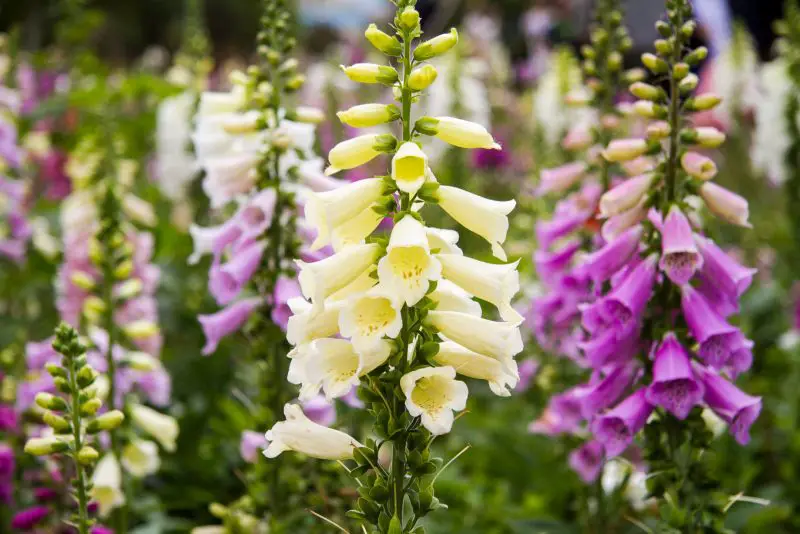Foxgloves are one of the most enchanting garden flowers, known for their tall, elegant spires and vibrant, bell-shaped blooms. Whether you’re a seasoned gardener or just starting out, understanding when foxgloves bloom is key to planning a garden full of color and charm throughout the growing season.
In this guide, you’ll discover everything you need to know about the foxglove’s blooming timeline and expert planting tips to ensure maximum flowers year after year. From choosing the right varieties to caring for your plants, get ready to create a stunning floral display that will captivate everyone who visits your garden.
Understanding Foxglove Bloom Timing

Foxgloves are celebrated for their tall, striking flower spikes that add vertical interest and vibrant color to gardens. While they typically bloom from late spring to early summer, the exact timing of their flowering period can vary widely based on several important factors. Understanding when foxgloves bloom helps gardeners plan their garden layout, coordinate companion planting, and maximize the length of their flowering season.
Typical Bloom Period
In most temperate climates, foxglove species begin to flower in May and continue through July, offering approximately 6 to 8 weeks of beautiful blossoms. During this time, flower spikes can grow impressively tall—anywhere from 2 to 5 feet—providing dramatic height in garden beds or borders. Foxgloves are predominantly biennial, meaning they spend their first year establishing foliage and roots and then produce flowers in their second year before completing their life cycle. However, some perennial varieties and hybrids can bloom annually once they mature, extending their presence in the garden over multiple seasons.
Factors Influencing Bloom Time
Several key factors influence the timing of foxglove blooms. Local climate plays a significant role; warmer regions with milder winters may see earlier bloom times, while colder zones often experience delays as plants respond to temperature cues. The planting method also matters—foxgloves started indoors or transplanted as nursery-grown plants tend to flower earlier than those directly sown outdoors in the spring. Sunlight exposure affects bloom development as well; foxgloves grown in partial shade may flower slightly later but often enjoy healthier foliage and longer-lasting blooms. Soil conditions, particularly nutrient levels and moisture availability, can speed up or slow down growth, impacting when flowers appear. Understanding and optimizing these variables allows gardeners to better predict and influence bloom timing.
Bloom Duration and Repeat Flowering
Foxgloves naturally have a relatively short bloom window, with peak flowering lasting several weeks. However, gardeners can sometimes encourage a second flush of flowers later in the season by regularly removing spent flower spikes—a process called deadheading. This helps redirect the plant’s energy from seed production back to flower formation. Perennial foxglove varieties are more likely to rebloom if given the right care, including sufficient water, fertilizer, and protection from stress. While biennial foxgloves typically bloom only once before dying, growing a mix of biennial and perennial types or staggering planting times can extend the overall period of floral display in the garden.
Choosing the Right Foxglove Varieties for Bloom Timing
Biennial vs. Perennial Foxgloves
One of the first considerations when choosing foxglove varieties is whether to grow biennial or perennial types. Biennial foxgloves are often favored for their impressive, tall flower spikes that develop in their second year. During their first year, these plants focus energy on developing healthy leaves and strong root systems. In the second year, they produce dramatic flower spikes that can reach up to 5 feet tall before completing their life cycle and dying back. While biennials provide a spectacular display, they require careful succession planting to maintain continuous blooms over multiple years.
Perennial foxgloves, in contrast, are capable of living and flowering for several years. These varieties tend to be shorter, bushier, and may produce multiple flower spikes across the growing season. Many perennials are hybrids bred to combine attractive bloom colors with the ability to rebloom annually. Growing perennials offers the advantage of lower maintenance once established, as they do not need replanting every year. Some gardeners choose to mix biennial and perennial foxgloves to balance the tall, striking floral displays with longer-lasting plants.
Early and Late Blooming Varieties
Foxglove varieties also differ in their bloom timing, which is an important factor when planning for a garden that boasts color for as long as possible. Early-blooming cultivars such as ‘Apricot Nectar’ and ‘Foxy’ begin flowering in late spring, offering some of the season’s first vibrant spikes. These early bloomers set the stage for summer color and can be paired with later flowering plants for a seamless transition in the garden.
On the other hand, late-blooming foxgloves like ‘Sutton’s Apricot’ and the ‘Excelsior Hybrid’ extend the bloom period well into midsummer or even early fall in some climates. These varieties often have strong, vigorous growth and tend to bloom over a longer period, sometimes with repeat flowering if cared for properly.
By selecting a combination of early and late bloomers, gardeners can create an extended display of foxglove flowers that lasts several months. Staggering these varieties in your garden beds or planting them in successive waves will help ensure that as one group of foxgloves finishes flowering, another is just beginning, maintaining continuous beauty and attracting pollinators throughout the growing season.
How to Plant Foxgloves for Maximum Blooms
Achieving lush, abundant foxglove blooms starts long before flowers appear—it begins with thoughtful planting and choosing the right site. By providing ideal conditions for growth, you set the stage for healthy plants that produce impressive flower spikes year after year.
Selecting the Ideal Location
Foxgloves naturally grow in woodland edges and shaded meadows, so recreating these conditions in your garden helps them thrive. Partial shade or dappled sunlight is ideal, especially in warmer regions where intense afternoon sun can scorch leaves and shorten bloom life. In cooler climates, foxgloves tolerate and often prefer full sun exposure, which encourages strong, upright flower spikes. Choose a planting location with well-draining soil to prevent root rot and avoid areas prone to waterlogging. Ample airflow around the plants is also important to reduce fungal diseases. Positioning foxgloves near taller shrubs or trees can provide natural shade and a visually pleasing layered garden effect.
Preparing the Soil
Healthy soil is fundamental for foxglove success. Before planting, thoroughly amend your garden bed with plenty of organic matter such as compost or well-rotted leaf mold. This not only enriches fertility but also improves soil structure and moisture retention. Foxgloves prefer slightly acidic to neutral soil with a pH between 5.5 and 7.0; a soil test can guide any necessary pH adjustments. Loosen the soil deeply—at least 12 inches—so roots can expand freely without obstruction. Avoid heavy clay soils or improve drainage by incorporating coarse sand or additional organic amendments. Well-prepared soil supports strong root systems and vigorous plant growth, leading to more prolific blooming.
Starting from Seed
Growing foxgloves from seed offers rewarding results and a wide variety of cultivars. Sow seeds indoors about 6 to 8 weeks before the last expected frost to give seedlings a strong start. Since foxglove seeds require light to germinate, scatter them lightly on the surface of moist seed-starting mix without covering. Maintain consistent moisture and keep temperatures between 65 to 70°F (18-21°C) for optimal germination. Thin seedlings once they develop true leaves to avoid overcrowding. Once outdoor conditions are suitable and seedlings have developed sturdy roots and foliage, harden them off gradually over 7 to 10 days before transplanting into the garden.
Transplanting Nursery-Grown Plants
If you prefer a quicker path to flowering, nursery-grown foxglove transplants are an excellent choice. Plant them in early spring after the last frost date to allow a full growing season for establishment and bloom production. Dig holes slightly larger than the nursery pots to accommodate the root ball comfortably. When transplanting, place the plant at the same soil depth it grew in the pot to prevent stem rot. After planting, water thoroughly to settle soil around the roots and reduce transplant shock. Applying a layer of mulch around the base conserves moisture, moderates soil temperature, and suppresses weeds, all of which promote healthy growth.
Timing Your Planting for Bloom Success
The timing of planting foxgloves greatly affects bloom size, timing, and overall plant health. Early spring planting is generally preferred because it provides foxgloves with an entire growing season to develop before flowering, resulting in larger, more vigorous plants with impressive flower spikes. In regions with mild winters, fall planting can also be successful, allowing roots to establish during cooler months. This method can result in earlier blooms the following spring. However, avoid planting during peak summer heat or when soil is too dry, as this stresses young plants and reduces bloom potential. Planning your planting schedule according to your local climate and frost dates optimizes bloom success and extends the flowering season.
Caring for Foxgloves During the Growing Season
Providing attentive care throughout the growing season is key to keeping foxgloves healthy, vigorous, and producing abundant, vibrant blooms. Proper watering, feeding, mulching, and maintenance ensure your foxglove plants reach their full flowering potential and stay resilient against pests and diseases.
Watering and Moisture Management
Foxgloves thrive best when their soil remains consistently moist but never waterlogged. Deep watering once or twice a week is generally sufficient, but this frequency should be increased during prolonged dry spells or heatwaves to prevent stress. Shallow, frequent watering is less effective because it encourages weak root systems and can increase the risk of fungal diseases. To minimize leaf wetness, which can promote powdery mildew and other fungal infections, avoid overhead watering. Instead, focus water at the base of the plants using drip irrigation or watering cans aimed directly at the soil. This targeted approach maintains the moisture foxgloves need without wetting their delicate foliage.
Fertilizing for Bloom Enhancement
Feeding foxgloves with appropriate nutrients supports robust growth and spectacular flowering. Apply a balanced, slow-release fertilizer early in the spring to provide essential nitrogen, phosphorus, and potassium for healthy leaf and root development. Throughout the growing season, supplement feeding every 4 to 6 weeks with a liquid fertilizer rich in phosphorus to promote large, colorful blooms. Be cautious not to over-fertilize, especially with high-nitrogen formulas, as this encourages lush foliage growth at the expense of flowers and may also weaken stems, making them more prone to bending or breaking.
Mulching Benefits
Applying a 2- to 3-inch layer of organic mulch such as shredded bark, leaf mold, or compost around foxglove plants delivers multiple benefits. Mulch helps retain soil moisture by reducing evaporation, regulates soil temperature to protect roots from extreme heat or cold, and suppresses weed growth that competes for nutrients and water. Organic mulch also gradually improves soil fertility and structure as it breaks down. It’s important to refresh mulch annually to maintain these benefits, but be careful to keep the mulch a few inches away from the plant’s crown to prevent moisture buildup that can lead to crown rot and fungal diseases.
Deadheading and Maintenance
Regular deadheading—the removal of spent flower spikes—is essential to extend the flowering period and encourage additional blooms. By cutting back faded flowers just above a healthy leaf whorl, you prevent the plant from diverting energy into seed production and instead channel resources into new flower spike development. During the fall, after the first frost has blackened foliage, cut plants back to ground level. This practice helps prepare foxgloves for winter dormancy, reduces the risk of overwintering diseases, and clears space for fresh spring growth. Additionally, keeping the garden clean of dead leaves and debris improves air circulation and reduces habitat for pests.
Managing Pests and Diseases to Protect Blooms
Common Pests
Foxgloves are susceptible to several pests, with aphids and slugs being the most common offenders. Aphids are small, soft-bodied insects that feed on plant sap, causing distorted growth and sometimes spreading viral diseases. To naturally control aphid populations, encourage beneficial insects like ladybugs, lacewings, and parasitic wasps in your garden. These predators help keep aphids in check without harmful chemicals. For slug control, physical barriers such as copper tape around garden beds or beer traps can be effective. Organic slug pellets made from iron phosphate provide a safe, environmentally friendly alternative to chemical baits, especially important for gardens frequented by pets or wildlife. Regular inspection of leaves and stems helps catch infestations early; remove heavily infested parts and dispose of them away from the garden.
Fungal Diseases
Fungal diseases such as powdery mildew and leaf spot thrive in humid, damp, and poorly ventilated environments, posing a significant threat to foxgloves. Powdery mildew appears as a white or gray powdery coating on leaves, while leaf spot causes dark, often circular lesions that can weaken foliage. Prevent fungal outbreaks by improving air circulation around plants—space foxgloves adequately and avoid overcrowding. Water plants early in the morning rather than late in the day to allow foliage ample time to dry before nightfall. Using drip irrigation instead of overhead watering minimizes leaf wetness, which fungi need to establish. Promptly remove and destroy infected leaves and debris to reduce sources of reinfection. In severe cases, organic fungicides based on sulfur or neem oil may help manage disease but should be used as a last resort and following label instructions carefully.
Extending Foxglove Blooms Through Propagation and Succession Planting
If you want your garden to enjoy the charming, bell-shaped blooms of foxgloves over an extended period, mastering propagation techniques and smart planting strategies is essential. These approaches help maintain a continuous display of flowers, ensuring your garden stays vibrant from late spring well into summer.
Self-Seeding and Dividing
Foxgloves are natural self-seeders, which means they can effortlessly spread in your garden when given the chance. To encourage self-seeding, allow some flower spikes to mature fully and produce seed pods. Once the seeds dry on the plant, they will fall to the soil, giving rise to new seedlings the following season. This method is a low-maintenance way to increase your foxglove population and maintain a naturalized look. However, to prevent overcrowding or unwanted spreading, you can selectively deadhead some flowers while letting others go to seed.
For perennial foxglove varieties that form clumps, dividing mature plants every few years helps rejuvenate growth and stimulate more vigorous flowering. Division is best done in early spring or fall when the plant is dormant or just beginning active growth. Carefully dig up the clump, separate it into smaller sections with healthy roots and shoots, and replant immediately. Dividing not only multiplies your plants but also helps maintain air circulation within the clumps, reducing disease risks.
Staggered Planting
To prolong the foxglove flowering season, stagger your sowing and transplanting times. Instead of planting all seeds or transplants at once, space them out in intervals of three to four weeks during the planting window. This method results in a sequence of flowering periods, as early plantings bloom first followed by later batches, creating a cascading effect of blossoms throughout late spring and summer.
Staggered planting is especially useful in climates with shorter growing seasons or unpredictable weather, allowing you to maximize bloom opportunities. Additionally, this technique provides a constant supply of fresh blooms for cutting gardens or pollinators, enhancing garden vitality and aesthetic appeal.
Preparing Foxgloves for Winter and Ensuring Next Year’s Blooms
Proper winter care is crucial for foxgloves to survive cold months and produce strong, healthy blooms in the following growing season. Taking the right steps to protect plants and support their dormancy helps maintain vigorous root systems and prevents winter damage.
Mulching for Winter Protection
As temperatures drop in late fall, applying a thick layer of organic mulch around the base of your foxglove plants is one of the most effective ways to shield roots from freezing and thawing cycles. A 3- to 4-inch layer of straw, shredded leaves, or bark mulch acts as insulation, maintaining more consistent soil temperatures and preventing frost heaving, which can dislodge shallow roots. Mulching also helps retain moisture during dry winter spells and suppresses weeds that might compete for nutrients come spring. However, be careful to avoid piling mulch directly against the plant’s crown or stem base, as excessive moisture buildup in this area can cause rot and fungal diseases during the dormant season.
Growing in Cold Climates
For gardeners in colder USDA hardiness zones, growing foxgloves successfully requires extra planning. Starting seeds indoors 6 to 8 weeks before the last expected frost is often the best way to get a jumpstart on the season. This protects delicate seedlings from frost damage and allows them to establish indoors in controlled conditions. Alternatively, purchasing nursery-grown foxglove plants in early spring for transplanting can reduce the risks of overwintering failure.
If you prefer direct outdoor sowing, fall planting is possible but requires understanding foxglove’s cold stratification needs—exposure to cold temperatures helps break seed dormancy and improves germination rates. However, seedlings and young plants may need additional protection from severe winter weather, such as frost cloths or cold frames, especially in areas with harsh freezes or heavy snow. By providing these safeguards, you help ensure your foxgloves survive winter and return with healthy, vibrant blooms the following year.
Frequently Asked Questions (FAQ) About Growing Foxglove
How long does it take for foxgloves to bloom after planting?
Foxgloves are generally biennial plants, which means they spend the first year developing foliage and roots, then bloom in the second year. If you start foxgloves from seed, expect blooms to appear about 12 to 18 months later, usually in late spring or early summer of the second year. However, some perennial foxglove varieties and nursery-grown transplants can produce flowers in the first growing season if planted early enough. To speed up flowering, start seeds indoors or purchase established plants from a nursery.
Can foxgloves grow in full sun, or do they need shade?
Foxgloves naturally grow in woodland edges where they receive dappled sunlight. They prefer partial shade, especially in warmer climates, to protect their leaves from scorching and to keep the soil cooler and moist. In cooler or temperate regions, foxgloves tolerate full sun well and often bloom more profusely. Excessive direct sunlight in hot climates can stress the plants, causing leaf damage and reducing flower longevity. Providing morning sun and afternoon shade is ideal.
What type of soil is best for growing foxgloves?
Foxgloves thrive in soil that drains well but retains some moisture. Loamy or sandy soil enriched with organic matter like compost or aged leaf mold creates the best environment for healthy root development. The ideal soil pH ranges from slightly acidic to neutral, between 5.5 and 7.0. Heavy clay soils or waterlogged conditions can cause root rot and other diseases, so amending such soils with organic materials to improve texture and drainage is highly recommended before planting.
How often should I water foxgloves during the growing season?
Maintaining consistent moisture is crucial for foxglove health, but overwatering can be harmful. Water deeply about once or twice per week, depending on rainfall and temperature. During hot or dry spells, increase watering frequency to prevent stress and support blooming. Avoid wetting the foliage directly, as wet leaves can promote fungal diseases like powdery mildew. Using drip irrigation or watering at the base helps keep the leaves dry and healthy.
How can I encourage foxgloves to bloom for a longer period?
Extending the flowering period of foxgloves involves several practices. First, stagger your planting by sowing seeds or transplanting at intervals of three to four weeks during the planting season; this results in successive blooms rather than all flowers appearing simultaneously. Second, regularly deadhead spent flower spikes by cutting just above a healthy leaf cluster; this redirects the plant’s energy into producing new flowers instead of seed production. In some perennial varieties, deadheading can even stimulate a second flush of blooms later in the summer.
Conclusion
Knowing when foxgloves bloom and how to plant and care for them properly allows gardeners to maximize their stunning floral display. With the right site, planting time, and ongoing care, foxgloves will reward you with tall, vibrant spikes that brighten any garden from late spring through summer. Using propagation and succession planting techniques further extends bloom time, ensuring your garden remains colorful and enchanting year after year.






